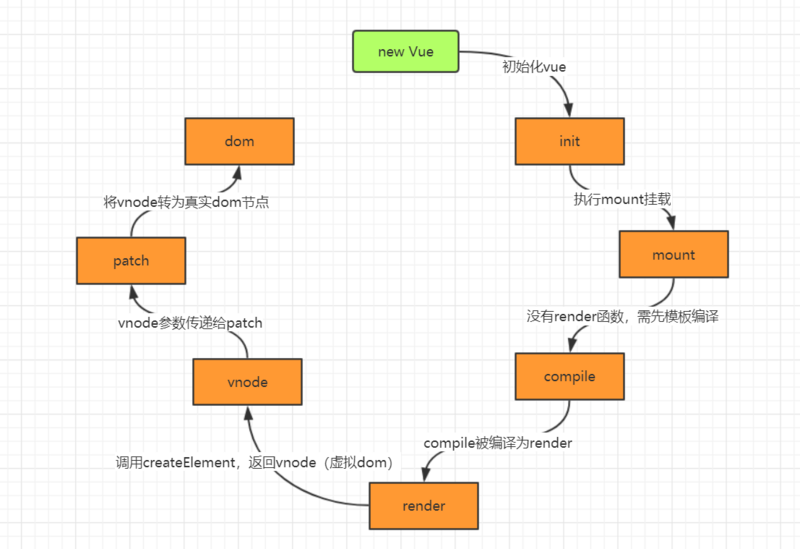keep-alive 原理
介绍
keep-alive 是 Vue 的一个内置组件,本身并不会渲染成为 DOM 元素,使用 keep-alive 包裹动态组件时,会缓存不活动的组件实例,而不是销毁它们。
使用
通常会搭配路由、动态组件使用:
<keep-alive :include="whiteList" :exclude="blackList" :max="amount">
<router-view></router-view>
</keep-alive>
<keep-alive :include="whiteList" :exclude="blackList" :max="amount">
<component :is="currentComponent"></component>
</keep-alive>
当组件在 keep-alive 内被切换,它的 activated 和 deactivated 这两个生命周期钩子函数将会被对应执行。
Notice
在 2.2.0 及其更高版本中,activated 和 deactivated 将会在 keep-alive 树内的所有嵌套组件中触发。
include & exclude
keep-alive 支持两个过滤属性 include 和 exclude:
include 定义缓存白名单,值为逗号分隔字符串、正则表达式或一个数组。只有名称匹配的组件会被缓存。
exclude 定义缓存黑名单,值为逗号分隔字符串、正则表达式或一个数组。任何名称匹配的组件都不会被缓存。优先级大于 include。
<!-- 逗号分隔字符串 -->
<keep-alive include="a,b">
<component :is="view"></component>
</keep-alive>
<!-- 正则表达式 (使用 `v-bind`) -->
<keep-alive :include="/a|b/">
<component :is="view"></component>
</keep-alive>
<!-- 数组 (使用 `v-bind`) -->
<keep-alive :include="['a', 'b']">
<component :is="view"></component>
</keep-alive>
匹配首先检查组件自身的 name 选项,如果 name 选项不可用,则匹配它的局部注册名称 (父组件 components 选项的键值)。匿名组件不能被匹配。
max
max 表示最多可以缓存多少组件实例。一旦这个数字达到了,在新实例被创建之前,已缓存组件中最久没有被访问的实例会被销毁掉。
这里 keep-alive 所采用的缓存策略为 LRU。
虚拟节点
我们知道像 keep-alive、transition、router-view 这些内置组件都不会作为真正的节点渲染到页面上,那么 Vue 是如何处理它们的呢?
我们看看 keep-alive 的源代码:
export default {
name: 'keep-alive',
abstract: true,
props: {
include: patternTypes,
exclude: patternTypes,
max: [String, Number],
},
...otherOptions, // 省略
}
keep-alive 组件中定义了一个 abstract 属性,Vue 在初始化生命周期的时候,为组件实例建立父子关系会根据 abstract 属性决定是否忽略某个组件。最后构建的组件树中就不会包含 keep-alive 组件。
Vue 的渲染过程
Vue 渲染的大体过程如下:

首先,Vue 在渲染的时候会调用原型上的 _render 函数将组件转化为一个 VNode 实例,而 _render 是通过调用 createElement 和 createEmptyVNode 两个函数进行转化。
createElement 的转化过程会根据不同的情形选择 new VNode 或者调用 createComponent 函数做 VNode 实例化。
完成 VNode 实例化后,这时候 Vue 调用原型上的 _update 函数把 VNode 渲染为真实 DOM,这个过程又是通过调用 __patch__ 函数完成的。
keep-alive 包裹的组件是如何使用缓存?
下面是 keep-alive 所涉及的主要代码:
// src/core/components/keep-alive.js
export default {
name: 'keep-alive',
abstract: true,
props: {
include: patternTypes, // 缓存白名单
exclude: patternTypes, // 缓存黑名单
max: [String, Number], // 缓存的组件实例数量上限
},
created() {
this.cache = Object.create(null) // 缓存虚拟dom
this.keys = [] // 缓存的虚拟dom的健集合
},
destroyed() {
for (const key in this.cache) {
// 删除所有的缓存
pruneCacheEntry(this.cache, key, this.keys)
}
},
mounted() {
// 实时监听黑白名单的变动
this.$watch('include', (val) => {
pruneCache(this, (name) => matches(val, name))
})
this.$watch('exclude', (val) => {
pruneCache(this, (name) => !matches(val, name))
})
},
render() {
const slot = this.$slots.default
const vnode: VNode = getFirstComponentChild(slot) // 找到第一个子组件对象
const componentOptions: ?VNodeComponentOptions = vnode && vnode.componentOptions
if (componentOptions) {
// 存在组件参数
// check pattern
const name: ?string = getComponentName(componentOptions) // 组件名
const { include, exclude } = this
if (
// 条件匹配
// not included
(include && (!name || !matches(include, name))) ||
// excluded
(exclude && name && matches(exclude, name))
) {
return vnode
}
const { cache, keys } = this
const key: ?string =
vnode.key == null // 定义组件的缓存key
? // same constructor may get registered as different local components
// so cid alone is not enough (#3269)
componentOptions.Ctor.cid + (componentOptions.tag ? `::${componentOptions.tag}` : '')
: vnode.key
if (cache[key]) {
// 已经缓存过该组件
vnode.componentInstance = cache[key].componentInstance
// make current key freshest
remove(keys, key)
keys.push(key) // 调整key排序
} else {
cache[key] = vnode // 缓存组件对象
keys.push(key)
// prune oldest entry
if (this.max && keys.length > parseInt(this.max)) {
// 超过缓存数限制,将第一个删除
pruneCacheEntry(cache, keys[0], keys, this._vnode)
}
}
vnode.data.keepAlive = true // 渲染和执行被包裹组件的钩子函数需要用到
}
return vnode || (slot && slot[0])
},
}
// pruneCacheEntry 会执行组件的 destroy 钩子函数并将缓存值置为 null
function pruneCacheEntry(cache: VNodeCache, key: string, keys: Array<string>, current?: VNode) {
const cached = cache[key]
if (cached && (!current || cached.tag !== current.tag)) {
cached.componentInstance.$destroy() // 执行组件的destroy钩子函数
}
cache[key] = null
remove(keys, key)
}
在 patch 阶段,会执行 createComponent 函数:
// src/core/vdom/patch.js
function createComponent(vnode, insertedVnodeQueue, parentElm, refElm) {
let i = vnode.data
if (isDef(i)) {
/**
* 第一次加载被包裹组件时 vnode.componentInstance 为 undefined
* 再次访问被包裹组件时,vnode.componentInstance 的值就是已经缓存的组件实例
*/
const isReactivated = isDef(vnode.componentInstance) && i.keepAlive
if (isDef((i = i.hook)) && isDef((i = i.init))) {
i(vnode, false)
}
if (isDef(vnode.componentInstance)) {
initComponent(vnode, insertedVnodeQueue)
insert(parentElm, vnode.elm, refElm) // 将缓存的DOM(vnode.elm)插入父元素中
if (isTrue(isReactivated)) {
reactivateComponent(vnode, insertedVnodeQueue, parentElm, refElm)
}
return true
}
}
}